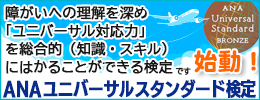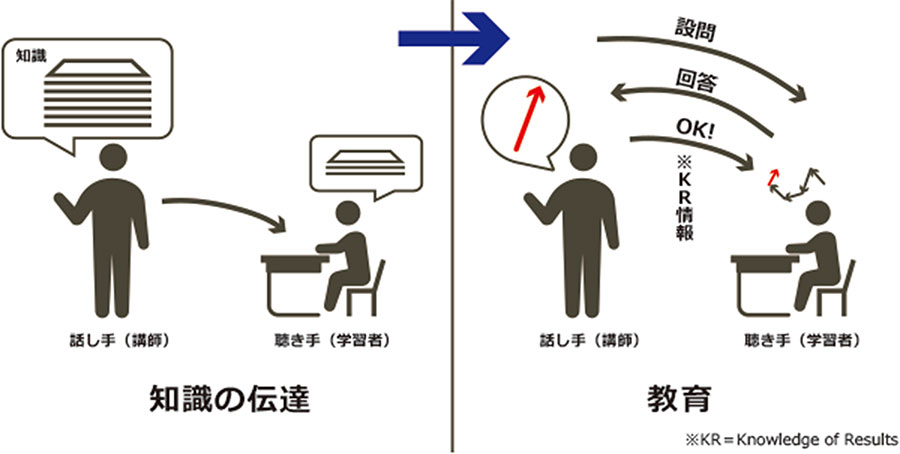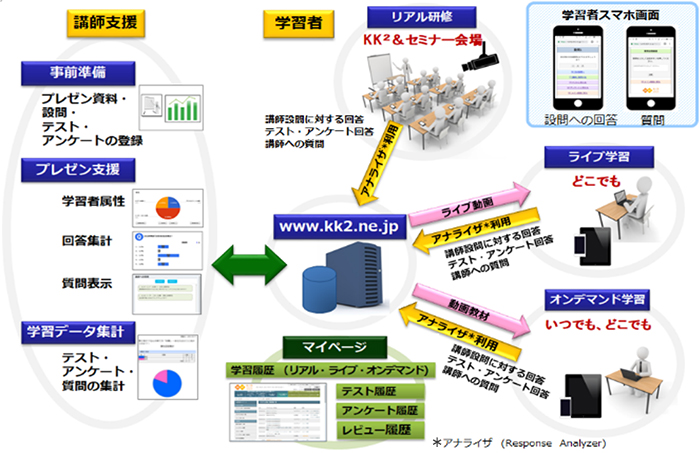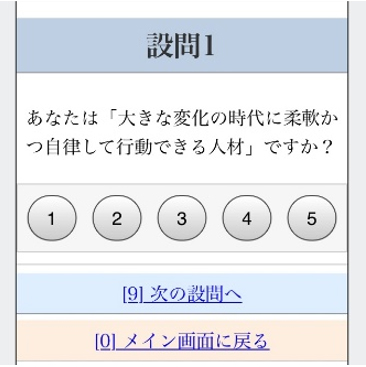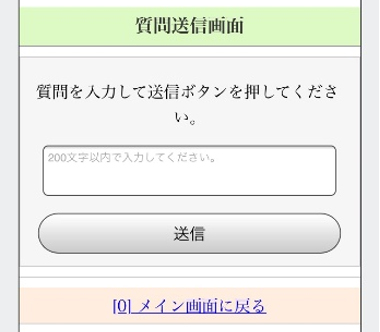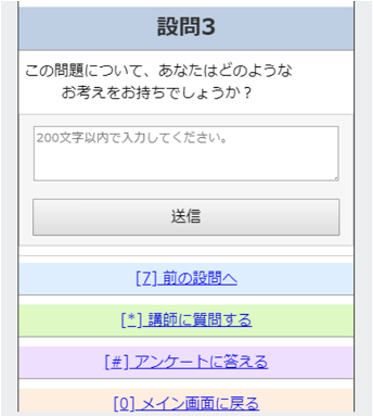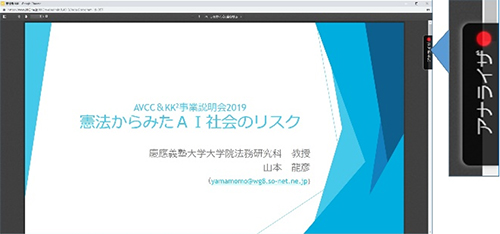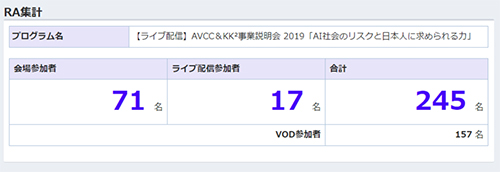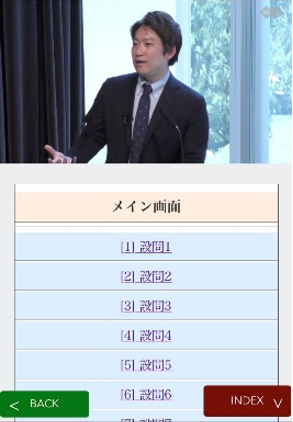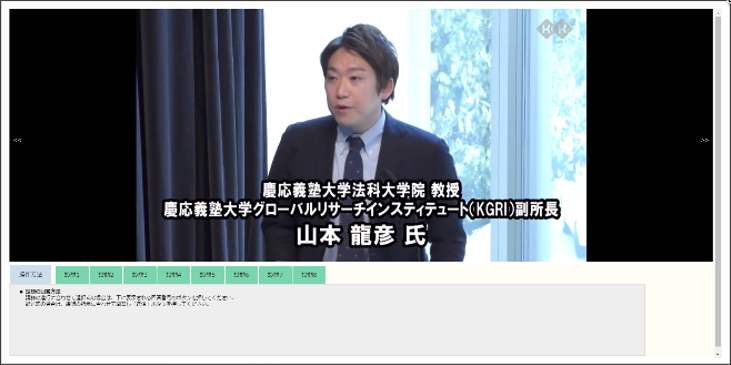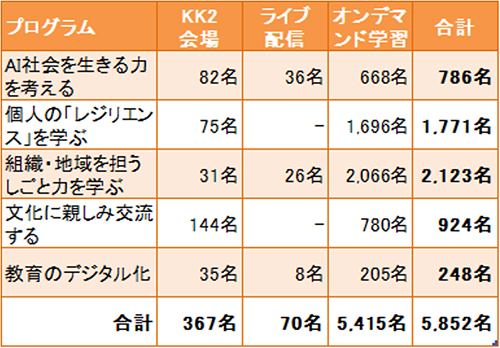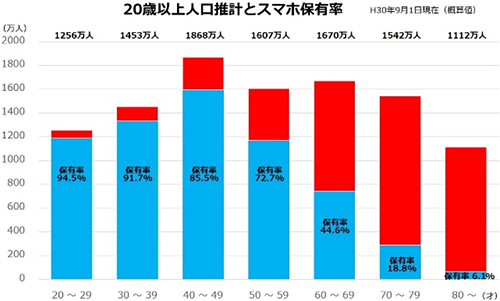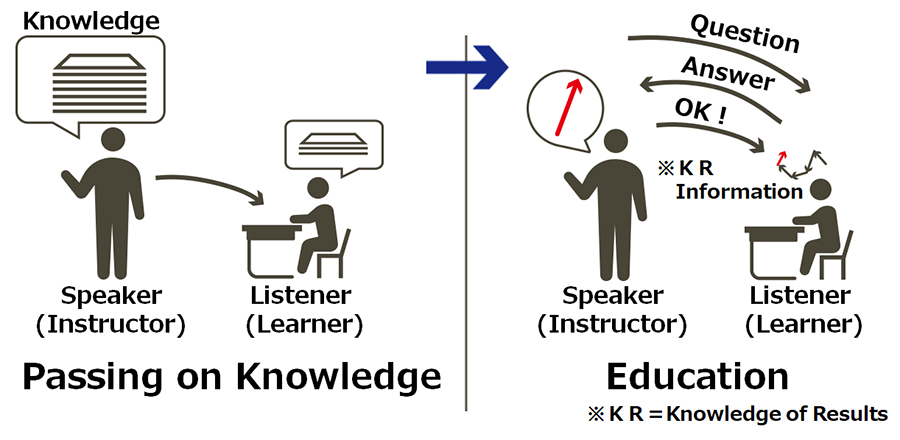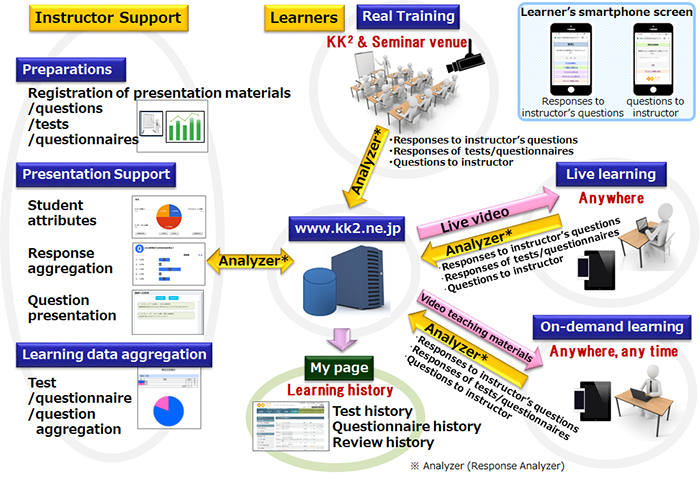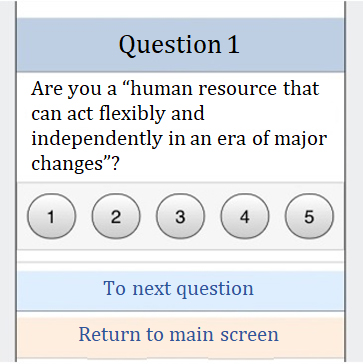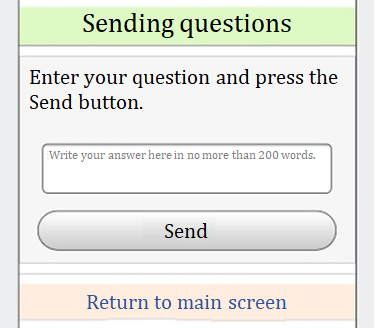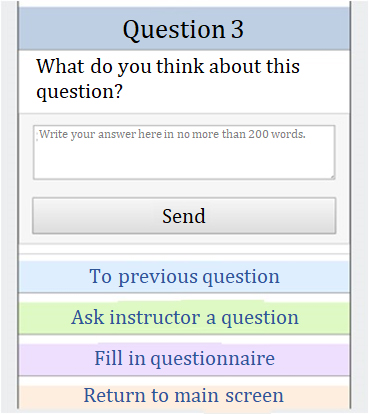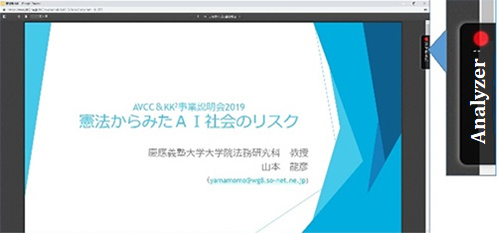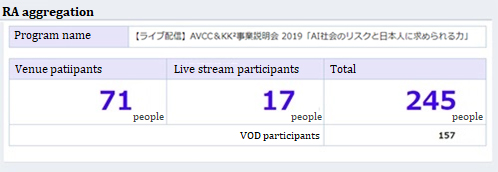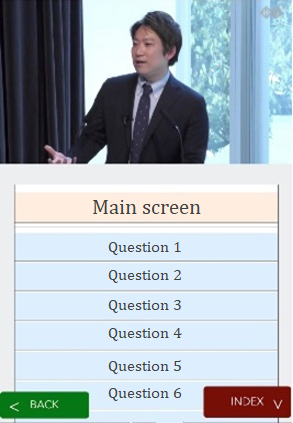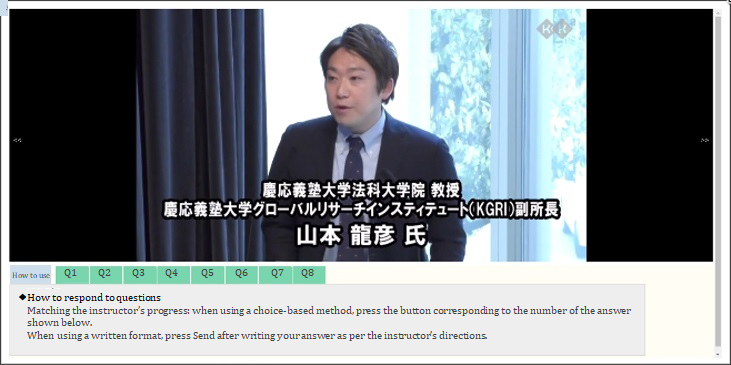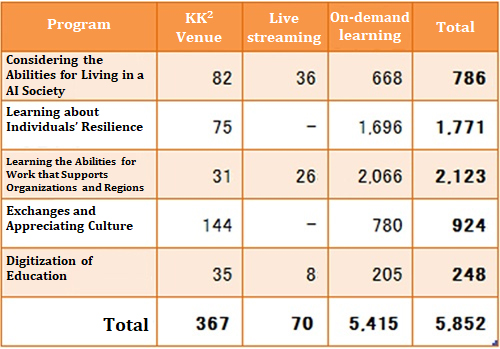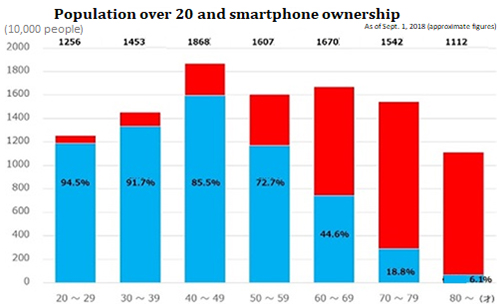【論文】DPPによる教育のデジタル化 / Digitization of Education Using DPP
<概要> 霞が関ナレッジスクエア(KK2)は、学校や企業では教えていない「しごと力」(社会で活躍する人がもつ力)を、世代を超え時空を超え学べるデジタル公民館です。本報告では、2019年4月より運用を開始したKK2_DPPを活用し実践する教育のデジタル化研究を紹介します。
1.はじめに
まずは皆さまに問いかけます。
『戦後連合国軍占領下でGHQによる三つの教育改革が進められた。 (1)従来の注入主義を改め、児童・生徒の自律的活動を進める「討議法」を取り入れる。(2)教科書だけを学ぶのではなく、児童・生徒が地域で見聞し学ぶ体験学習活動を展開する。(3)視聴覚教材の利用を大いに進める。戦後約75年が経ち、三つの教育改革は我国の教育現場に定着したでしょうか?』
定着は〇、定着しないは×とし、
1.(1)〇 (2)〇 (3)〇
2.(1)× (2)〇 (3)〇
3.(1)× (2)× (3)〇
4.(1)× (2)× (3)×
5.わからない、その他。
皆さまは1~5どれを選ばれますか?
我国の学校教育・企業内教育・プレゼンテーションの多くは、話し手(講師)が一方的に説明する旧態依然とした指導法が採られ、話し手が上手に説明すれば聴き手(学習者)は理解すると錯覚しています。理解できないのは学習者側の課題と捉え、自らの指導法を顧みることがあまりありません。しかしこれでは、単なる知識の伝達に過ぎず教育ではありません。
『戦後連合国軍占領下でGHQによる三つの教育改革が進められた。 (1)従来の注入主義を改め、児童・生徒の自律的活動を進める「討議法」を取り入れる。(2)教科書だけを学ぶのではなく、児童・生徒が地域で見聞し学ぶ体験学習活動を展開する。(3)視聴覚教材の利用を大いに進める。戦後約75年が経ち、三つの教育改革は我国の教育現場に定着したでしょうか?』
定着は〇、定着しないは×とし、
1.(1)〇 (2)〇 (3)〇
2.(1)× (2)〇 (3)〇
3.(1)× (2)× (3)〇
4.(1)× (2)× (3)×
5.わからない、その他。
皆さまは1~5どれを選ばれますか?
我国の学校教育・企業内教育・プレゼンテーションの多くは、話し手(講師)が一方的に説明する旧態依然とした指導法が採られ、話し手が上手に説明すれば聴き手(学習者)は理解すると錯覚しています。理解できないのは学習者側の課題と捉え、自らの指導法を顧みることがあまりありません。しかしこれでは、単なる知識の伝達に過ぎず教育ではありません。
「教育」とは、
(1)目標行動を明確にする。:学習者の目標行動を明確にします。
(2)学習者に行動させる。:講師は、例題を与えたり、問いかけをしたりすることにより、学習者に考えさせます。学習者は自ら行動することが重要で、受動的に説明を聴きノートを取るだけでは教育効果は少ない。
(3)目標行動をした学習者に「それでよいのだ」と伝える。:これはKR情報(Knowledge of Results)と呼ばれ、講師が学習者行動に対してKR情報を発することで、学習者はインスパイアされます。
この三点が「教育」の特長であり「知識の伝達」と違うところです。
(1)目標行動を明確にする。:学習者の目標行動を明確にします。
(2)学習者に行動させる。:講師は、例題を与えたり、問いかけをしたりすることにより、学習者に考えさせます。学習者は自ら行動することが重要で、受動的に説明を聴きノートを取るだけでは教育効果は少ない。
(3)目標行動をした学習者に「それでよいのだ」と伝える。:これはKR情報(Knowledge of Results)と呼ばれ、講師が学習者行動に対してKR情報を発することで、学習者はインスパイアされます。
この三点が「教育」の特長であり「知識の伝達」と違うところです。
2.KK2_DPP*のシステム構成
霞が関ナレッジスクエア(KK2)は、教育の特長を踏まえ、教育の質の向上と学習機会の拡大を図るため、KK2_DPP(デジタルプレゼンテーションプラットフォーム)を開発、サービス提供を開始しました。
DPPには、(1)教育の質の向上を図るアナライザー(Response Analyzer)機能、(2)学習機会の拡大を図る遠隔教育機能、(3)教育運営をサポートする教育研修支援機能(LMS)、の三つのシステムで構成されます。
※1 DPPはクラウドサービスです。教育研修の場にWi-Fi環境があれば、いつでもどこでもご利用いただけます。
※2 DPPはKK2サイトの機能です。講師・学習者はKK2サイトでWEB会員登録することがDPPご利用の必要条件となります。
KK2 ⇒ www.kk2.ne.jp
※3 DPPはISO29990の基本的要求事項を満たす学習サービス品質の担保を目指します。
※4 KK2デジタルプレゼンテーションプラットフォームは株式会社メディアリンクより平成31年4月5日、特許を取得いたしました。 特許番号 第6507328号
DPPには、(1)教育の質の向上を図るアナライザー(Response Analyzer)機能、(2)学習機会の拡大を図る遠隔教育機能、(3)教育運営をサポートする教育研修支援機能(LMS)、の三つのシステムで構成されます。
※1 DPPはクラウドサービスです。教育研修の場にWi-Fi環境があれば、いつでもどこでもご利用いただけます。
※2 DPPはKK2サイトの機能です。講師・学習者はKK2サイトでWEB会員登録することがDPPご利用の必要条件となります。
KK2 ⇒ www.kk2.ne.jp
※3 DPPはISO29990の基本的要求事項を満たす学習サービス品質の担保を目指します。
※4 KK2デジタルプレゼンテーションプラットフォームは株式会社メディアリンクより平成31年4月5日、特許を取得いたしました。 特許番号 第6507328号
(1)アナライザー(Response Analyzer)
DPPの特長であるアナライザー(Response Analyzer)は、学習者が手元に保有する情報端末(スマートホンかパソコン)を使い、学習者の反応(レスポンス)を集計・分析(アナライズ)し、リアルタイムに講師にフィードバックします。講師と対面の学習者は勿論、サテライト会場や職場・自宅でライブ学習する学習者と講師をつなぐ対話型の学びを可能にします。
情報端末では、
(a)QRコードを読み取りまずプログラムに参加を登録します。この時点で講師は全参加者属性(性別、年代、職業)を把握、それを学習者と共有することができます。
(b)講師からの「設問」に対して、五択一選択で回答できます。
DPPの特長であるアナライザー(Response Analyzer)は、学習者が手元に保有する情報端末(スマートホンかパソコン)を使い、学習者の反応(レスポンス)を集計・分析(アナライズ)し、リアルタイムに講師にフィードバックします。講師と対面の学習者は勿論、サテライト会場や職場・自宅でライブ学習する学習者と講師をつなぐ対話型の学びを可能にします。
情報端末では、
(a)QRコードを読み取りまずプログラムに参加を登録します。この時点で講師は全参加者属性(性別、年代、職業)を把握、それを学習者と共有することができます。
(b)講師からの「設問」に対して、五択一選択で回答できます。
(c)自由記述による設問回答もできます。
その回答集計は速やかに行われそれを学習者と共有することができます。
(d)学習者は理解できないことがあった時、質問したい時、いつでも情報端末から質問できます。
(d)学習者は理解できないことがあった時、質問したい時、いつでも情報端末から質問できます。
学習者から質問が入ると、DPP画面の赤いパイロットが点灯し、他に指定のメールアドレスにその質問内容を送信できます。
(2)遠隔教育システム
DPPでは、研修会場に居る学習者・ライブ配信による学習者・オンデマンド学習による学習者を一元的に管理する遠隔教育システムです。
DPPでは、研修会場に居る学習者・ライブ配信による学習者・オンデマンド学習による学習者を一元的に管理する遠隔教育システムです。
(a) リアル研修
KK2施設に限らず、学校の教室、企業会議室、公民館でも、Wi-Fi環境があればDPPの利用が可能です。
(b) ライブ学習
リアル研修の中継映像音声を、KK2サイトにリアルタイムで連携すれば全世界にライブ配信します。DPPはMax500台の情報端末にライブ配信が可能です。
※ライブ配信では、平均15秒のタイムディレイが発生します。アナライザーを利用する際に運用上の配慮が必要です。
KK2施設に限らず、学校の教室、企業会議室、公民館でも、Wi-Fi環境があればDPPの利用が可能です。
(b) ライブ学習
リアル研修の中継映像音声を、KK2サイトにリアルタイムで連携すれば全世界にライブ配信します。DPPはMax500台の情報端末にライブ配信が可能です。
※ライブ配信では、平均15秒のタイムディレイが発生します。アナライザーを利用する際に運用上の配慮が必要です。
(c) オンデマンド学習
KK2プログラムはすべて収録編集し、オンデマンド学習用に無料で公開しています。
(3) 教育研修支援システム(LMS)
DPPは講師をサポートする教育研修支援機能を持ちます。
(a) プログラムの事前準備
・設問と資料
まずプログラム(講座)を登録後、講義中に学習者に問いかける「設問*」と提示する「資料(スライド)*」を事前に登録します。
※ 設問は選択式(最大五択)と記述式
※ 資料はPDF(Max.10M)のみ
講義に際しては資料を手元を持つ必要はなく、DPPのプレゼンテーション機能で資料提示します。
・参加者属性
性別・年代・職業以外、何年生?とか経験年数?等必要な属性を設定できます。最大五択。
・テスト
最大五択のテストを用意し、合格点を設定できます。学習者は情報端末でテストを受け採点結果もリアルタイムで自己確認できます。
・アンケート
選択式、記述式のアンケートを用意し、学習者は情報端末から手軽に回答、DPPはリアルタイムに分析出力(PDF)も可能です。
(b) プレゼンテーション支援
話し手(講師)は資料(スライド)を提示しながら話し、時々学習者にアナライザーで問いかけ反応を観る。回答集計に基づき学習者同士の議論もファシリテートします。学習者より質問があれば、その内容を他の学習者と共有し質問に答えます。こういったプレゼンテーション展開を、DPPは一画面でマウス操作だけでスムースに進められます。
(c) 学習データ集計
学習者の情報(データ)は時系列にプログラム別に収集・分析・蓄積されビッグデータとなります。これらの解析により教育のPDCAサイクルを回すことが可能です。
(d) 学習者支援(マイページ)
KK2にWEB会員登録するとマイページ(各人のポートフォリオ)が自動的に生成されます。
・学習履歴(リアル・ライブ・オンデマンド)
・テスト履歴
・アンケート履歴
・レビュー履歴
KK2プログラムはすべて収録編集し、オンデマンド学習用に無料で公開しています。
(3) 教育研修支援システム(LMS)
DPPは講師をサポートする教育研修支援機能を持ちます。
(a) プログラムの事前準備
・設問と資料
まずプログラム(講座)を登録後、講義中に学習者に問いかける「設問*」と提示する「資料(スライド)*」を事前に登録します。
※ 設問は選択式(最大五択)と記述式
※ 資料はPDF(Max.10M)のみ
講義に際しては資料を手元を持つ必要はなく、DPPのプレゼンテーション機能で資料提示します。
・参加者属性
性別・年代・職業以外、何年生?とか経験年数?等必要な属性を設定できます。最大五択。
・テスト
最大五択のテストを用意し、合格点を設定できます。学習者は情報端末でテストを受け採点結果もリアルタイムで自己確認できます。
・アンケート
選択式、記述式のアンケートを用意し、学習者は情報端末から手軽に回答、DPPはリアルタイムに分析出力(PDF)も可能です。
(b) プレゼンテーション支援
話し手(講師)は資料(スライド)を提示しながら話し、時々学習者にアナライザーで問いかけ反応を観る。回答集計に基づき学習者同士の議論もファシリテートします。学習者より質問があれば、その内容を他の学習者と共有し質問に答えます。こういったプレゼンテーション展開を、DPPは一画面でマウス操作だけでスムースに進められます。
(c) 学習データ集計
学習者の情報(データ)は時系列にプログラム別に収集・分析・蓄積されビッグデータとなります。これらの解析により教育のPDCAサイクルを回すことが可能です。
(d) 学習者支援(マイページ)
KK2にWEB会員登録するとマイページ(各人のポートフォリオ)が自動的に生成されます。
・学習履歴(リアル・ライブ・オンデマンド)
・テスト履歴
・アンケート履歴
・レビュー履歴
3.KK2でのDPP活用報告
2019年4月1日~7月11日までの、KK2プログラムの参加者は以下の通りです。
4.DPPの評価
DPP利用プログラムが「教育の質向上」にどう寄与できたかを報告します。
(1)学習者からの評価
(a) 参加意識
自分の考えを意思表示することで受動的から能動的に変わる。
(b) 双方向性
問いかけられ、回答を考える講義なので眠くならない。
(c) 知識定着
問いかけ、回答、KR情報というサイクルで知識が定着する。
(d) 自分と他者の意見比較
他者がどう考えているのか解り自分と比較し興味深い。
(e) 唯一解の無い問題
唯一解の無い問題への思考討論を助ける。
(2)話し手(講師)からの評価
(a) 講義内容の見直し
DPPを使い、学習者への設問を作る授業準備は、「少しの労苦」と「多大な内容整理」をもたらします。
(b) 教師の役割の変化
DPPを使うことで、話し手(講師)の役割は、Teacher(教授者)⇒Facilitator(促進者)に変わっていくことが求められる。
(1)学習者からの評価
(a) 参加意識
自分の考えを意思表示することで受動的から能動的に変わる。
(b) 双方向性
問いかけられ、回答を考える講義なので眠くならない。
(c) 知識定着
問いかけ、回答、KR情報というサイクルで知識が定着する。
(d) 自分と他者の意見比較
他者がどう考えているのか解り自分と比較し興味深い。
(e) 唯一解の無い問題
唯一解の無い問題への思考討論を助ける。
(2)話し手(講師)からの評価
(a) 講義内容の見直し
DPPを使い、学習者への設問を作る授業準備は、「少しの労苦」と「多大な内容整理」をもたらします。
(b) 教師の役割の変化
DPPを使うことで、話し手(講師)の役割は、Teacher(教授者)⇒Facilitator(促進者)に変わっていくことが求められる。
5.おわりに
AI社会が進展する中、情報端末としてのスマートフォンが仕事や生活に浸透している。本研究は、このスマホを利用し教育の質向上を追究するものだが、リアル研修に留まらず遠隔教育にも効果があり、学びの格差解消に寄与できることはよろこばしい。
一方我国のスマホ保有状況をみると、高齢者になればなるほど保有率は低く、国民の中にスマホの壁(ITデバイド)が立ちはだかっている。
一方我国のスマホ保有状況をみると、高齢者になればなるほど保有率は低く、国民の中にスマホの壁(ITデバイド)が立ちはだかっている。
令和の世では、高齢者がスマホの恩恵に浴せるような地域の学び合い活動の必要性を痛感する。
謝辞:共に研究いただいた株式会社メディアリンクと実践の場を与えていただいたKK2の皆さまに感謝します。
謝辞:共に研究いただいた株式会社メディアリンクと実践の場を与えていただいたKK2の皆さまに感謝します。
久保田 了司
一般財団法人高度映像情報センター (AVCC) 理事長
一般財団法人高度映像情報センター (AVCC) 理事長
参考文献
[1] 藤田廣一(1980.02.15):学習反応分析装置活用の基本(アナライザーの使い方),研究資料56p
[2] 藤田廣一(1981.06):わるい教育,よい教育,日本機械学会誌,Vol84,No.751
[3] 永岡慶三(2005):携帯電話利用によるレスポンス・アナライザ・システム,人間科学研究,Vol.18,No.1
[4] 永岡慶三(2019.05.27):DPP利用による学びの質の向上,KK2NO.1教育のデジタル化研究会講義,
[1] 藤田廣一(1980.02.15):学習反応分析装置活用の基本(アナライザーの使い方),研究資料56p
[2] 藤田廣一(1981.06):わるい教育,よい教育,日本機械学会誌,Vol84,No.751
[3] 永岡慶三(2005):携帯電話利用によるレスポンス・アナライザ・システム,人間科学研究,Vol.18,No.1
[4] 永岡慶三(2019.05.27):DPP利用による学びの質の向上,KK2NO.1教育のデジタル化研究会講義,
Digitization of Education Using DPP
Abstract: Kasumigaseki Knowledge Square (KK2) is a digital community center where people can learn, unhampered by generation, time or space, the “abilities to work” (the abilities needed to be an active part of society) that are not taught in schools. This report presents research into the digitalization of education that has utilized the KK2_DPP that started operation in April 2019.
1. Introduction
I would like to start out by asking you all a question.
“Three educational reforms were pursued by GHQ under the post-war Allied occupation of Japan. These were (1) revising the old top-down rote memorization style of education and moving to a discussion-based style that promoted autonomous actions by children and pupils; (2) rather than learning solely from textbooks, children and pupils are given opportunities for hands-on learning in the local region; and (3) promote the use of audio-visual teaching materials. Now, 75 years after the war, have these three reforms taken root in our schools?”
Using 〇 to represent “Yes” and to represent “No,” which of the following would you choose?
1.(1)〇 (2)〇 (3)〇
2.(1)× (2)〇 (3)〇
3.(1)× (2)× (3)〇
4.(1)× (2)× (3)×
5.Don’t know / Other
In the majority of cases, school education, company training, and presentations in Japan use the old-style of instruction where the speaker (the instructor) talks and everyone else listens. This falsely assumes that the speaker is able to explain things clearly enough for the listeners (the learners) to understand. Failure to understand is seen as the learner’s problem, and the instructors do not reflect on their own teaching methods. However, this is merely the passing on of knowledge, and not actual education.
“Three educational reforms were pursued by GHQ under the post-war Allied occupation of Japan. These were (1) revising the old top-down rote memorization style of education and moving to a discussion-based style that promoted autonomous actions by children and pupils; (2) rather than learning solely from textbooks, children and pupils are given opportunities for hands-on learning in the local region; and (3) promote the use of audio-visual teaching materials. Now, 75 years after the war, have these three reforms taken root in our schools?”
Using 〇 to represent “Yes” and to represent “No,” which of the following would you choose?
1.(1)〇 (2)〇 (3)〇
2.(1)× (2)〇 (3)〇
3.(1)× (2)× (3)〇
4.(1)× (2)× (3)×
5.Don’t know / Other
In the majority of cases, school education, company training, and presentations in Japan use the old-style of instruction where the speaker (the instructor) talks and everyone else listens. This falsely assumes that the speaker is able to explain things clearly enough for the listeners (the learners) to understand. Failure to understand is seen as the learner’s problem, and the instructors do not reflect on their own teaching methods. However, this is merely the passing on of knowledge, and not actual education.
Education is
(1)Making the goals and actions of learners clear;
(2)having learners think and act by asking questions of the instructor (merely passively listening to explanations will not deepen understanding),
(3)by telling learners who have goal actions “that is fine” (KR Information: Knowledge of Results) learners are inspired.
These three points are the characteristics of education and where it differs from passing on knowledge.
(1)Making the goals and actions of learners clear;
(2)having learners think and act by asking questions of the instructor (merely passively listening to explanations will not deepen understanding),
(3)by telling learners who have goal actions “that is fine” (KR Information: Knowledge of Results) learners are inspired.
These three points are the characteristics of education and where it differs from passing on knowledge.
2.KK2_DPP* System Configuration
Building on these characteristics of education, Kasumigaseki Knowledge Square (KK2) has developed KK2_DPP (Digital Presentation Platform) to improve the quality of education and expand opportunities for learning and has started offering it as a service.
The DPP system is made up of (1) a response analyzer function to improve educational quality;(2)a remote learning function to expand opportunities for learnings, and(3)an education and training support function (LMS) that supports operating education.
※1 DPP is a cloud service. If the teaching environment has Wi-Fi, it can be used anytime, anyplace.
※2 DPP is a function of the KK2 site. Instructors and learners need to register as web members on the KK2 site to use the DPP.
KK2 ⇒ www.kk2.ne.jp
※3 The DPP aims to ensure learning service quality that meets the basic requirements of ISO29990.
※4 The KK2 Digital Presentation Platform has been granted a patent as of April 5, 2019, for Media Links Co., Ltd. Patent No. 6507328.
The DPP system is made up of (1) a response analyzer function to improve educational quality;(2)a remote learning function to expand opportunities for learnings, and(3)an education and training support function (LMS) that supports operating education.
※1 DPP is a cloud service. If the teaching environment has Wi-Fi, it can be used anytime, anyplace.
※2 DPP is a function of the KK2 site. Instructors and learners need to register as web members on the KK2 site to use the DPP.
KK2 ⇒ www.kk2.ne.jp
※3 The DPP aims to ensure learning service quality that meets the basic requirements of ISO29990.
※4 The KK2 Digital Presentation Platform has been granted a patent as of April 5, 2019, for Media Links Co., Ltd. Patent No. 6507328.
(1)Analyzer (Response Analyzer)
One feature of DPP, its analyzer (Response Analyzer), uses the learners’ own information terminals (computers or smartphones) to aggregate and analyze their responses, and feed them back to the instructor in real time. This makes it possible for one-to-one live learning between learner and instructor even at satellite venues, at home or at work, in addition of course to actual face-to-face learning.
In the information terminals:
(a)First scan the QR code and register to take part in the program. At this point, the instructor can learn the attributes of all participants (sex, age, occupation) and share them with the learners.
(b)Learners can select one of five responses to questions posed by the instructor.
One feature of DPP, its analyzer (Response Analyzer), uses the learners’ own information terminals (computers or smartphones) to aggregate and analyze their responses, and feed them back to the instructor in real time. This makes it possible for one-to-one live learning between learner and instructor even at satellite venues, at home or at work, in addition of course to actual face-to-face learning.
In the information terminals:
(a)First scan the QR code and register to take part in the program. At this point, the instructor can learn the attributes of all participants (sex, age, occupation) and share them with the learners.
(b)Learners can select one of five responses to questions posed by the instructor.
(c) Responses to questions can also be made using comments.
Aggregation of these responses can be done promptly and they can be shared with the learners.
(d)When learners are unable to understand something, or want to ask a question, they can do so from their information terminal.
(d)When learners are unable to understand something, or want to ask a question, they can do so from their information terminal.
When a question comes from a learner, the red pilot light on the DPP screen comes on, and you can send the question to other specific e-mail addresses.
(2) Remote Learning System
DPP provides a remote learning system that can manage learners in the training venue, learners connecting through live streaming, and on-demand learners all in the same way.
DPP provides a remote learning system that can manage learners in the training venue, learners connecting through live streaming, and on-demand learners all in the same way.
(a) Real training
In addition to KK2 facilities, DPP can be used anywhere there is Wi-Fi, such as school classrooms, company meeting rooms, and community centers.
(b) Live learning
Connecting live video and audio from real training in real time to the KK2 site allows it to be broadcast live worldwide. DPP can connect live up to a maximum of 500 information terminals.
※Live streaming comes with a time delay of 15 seconds on average. Consideration for this will be required when using the Analyzer.
In addition to KK2 facilities, DPP can be used anywhere there is Wi-Fi, such as school classrooms, company meeting rooms, and community centers.
(b) Live learning
Connecting live video and audio from real training in real time to the KK2 site allows it to be broadcast live worldwide. DPP can connect live up to a maximum of 500 information terminals.
※Live streaming comes with a time delay of 15 seconds on average. Consideration for this will be required when using the Analyzer.
(c) On-demand learning
KK2 programs are all recorded and edited and made available for on-demand study at no cost.
(3)Education and training support system (LMS)
The DPP has an education and training support system to support instructors.
(a) Preparing for the program
・Questions and materials
After registering a program (class), register the materials (slides)* to show and the questions* to be given to the learners during the lecture.
※ Questions can be multi-choice (up to five choices) or written style
※ Only PDF files (max. of 10 MB) can be used.
There is no need to keep the materials at hand during the lecture, as they can be presented using the DPP’s presentation function.
・Participant details
Other than sex, age, and occupation, you can set any other required attributes such as school year or years of experience. A maximum of five can be selected.
・Tests
Up to five tests can be prepare, and the passing grades set. Learners can take the tests on their information terminals and check their results in real time.
・Questionnaires
Multi-choice or written-style questionnaires can be prepared, which learners can easily respond to from their information terminals and the DPP can provide analysis outputs in real time in PDF format.
(b) Presentation support
The speaker (the instructor) talks while showing materials (slides), and sometimes asks questions of the learners and watches their responses. It also facilitates discussions between learners themselves based on response aggregation. If learners have a question, the question can be shared with other learners, who can respond to it. This short of presentation style can be done smoothly with DPP by just using a mouse on a single screen.
(c) Learning data aggregation
Information (data) about learners is collection, analyzed, and stored chronologically for each program, becoming big data. These analyses allow the PDCA cycle to be used.
(d) Learner support (“My Page”)
Registering as a web member on the KK2 site automatically generates a personal page (a portfolio for each person).
・Study history (Real, Live, On-demand)
・Test history
・Questionnaire history
・Review history
KK2 programs are all recorded and edited and made available for on-demand study at no cost.
(3)Education and training support system (LMS)
The DPP has an education and training support system to support instructors.
(a) Preparing for the program
・Questions and materials
After registering a program (class), register the materials (slides)* to show and the questions* to be given to the learners during the lecture.
※ Questions can be multi-choice (up to five choices) or written style
※ Only PDF files (max. of 10 MB) can be used.
There is no need to keep the materials at hand during the lecture, as they can be presented using the DPP’s presentation function.
・Participant details
Other than sex, age, and occupation, you can set any other required attributes such as school year or years of experience. A maximum of five can be selected.
・Tests
Up to five tests can be prepare, and the passing grades set. Learners can take the tests on their information terminals and check their results in real time.
・Questionnaires
Multi-choice or written-style questionnaires can be prepared, which learners can easily respond to from their information terminals and the DPP can provide analysis outputs in real time in PDF format.
(b) Presentation support
The speaker (the instructor) talks while showing materials (slides), and sometimes asks questions of the learners and watches their responses. It also facilitates discussions between learners themselves based on response aggregation. If learners have a question, the question can be shared with other learners, who can respond to it. This short of presentation style can be done smoothly with DPP by just using a mouse on a single screen.
(c) Learning data aggregation
Information (data) about learners is collection, analyzed, and stored chronologically for each program, becoming big data. These analyses allow the PDCA cycle to be used.
(d) Learner support (“My Page”)
Registering as a web member on the KK2 site automatically generates a personal page (a portfolio for each person).
・Study history (Real, Live, On-demand)
・Test history
・Questionnaire history
・Review history
3.Reporting DPP activities on KK2
Participants in KK2 programs between April 1 and July 11, 2019, were as follows.
4.DPP Evaluations
This reports on how the DPP usage program has contributed to improving education.
(1)Evaluations from learners
(a) Participation awareness
My ideas have changed from passive to active through presenting my thoughts.
(b) Bidirectionality
Classes where learners are asked questions and need to think of responses are not ones where you fall asleep.
(c) Retention of knowledge
Knowledge is retained through the cycle of questions, responses, and KR information.
(d) Comparing opinions with self and others
Understanding how others think and comparing it with your own ideas is very interesting.
(e) Questions that don’t have a single answer
Helps with thoughts and discussions for questions without single answers.
(2) Evaluation from speakers (instructors)
(a) Revision of lecture content
Using the DPP to prepare for classes by creating questions for learners generates “a little hard work” and “a great deal of content preparation.”
(b) Changes to the role of the teacher
Using the DPP means that the role of the speaker (instructor) needs to change from a teacher to a facilitator.
(1)Evaluations from learners
(a) Participation awareness
My ideas have changed from passive to active through presenting my thoughts.
(b) Bidirectionality
Classes where learners are asked questions and need to think of responses are not ones where you fall asleep.
(c) Retention of knowledge
Knowledge is retained through the cycle of questions, responses, and KR information.
(d) Comparing opinions with self and others
Understanding how others think and comparing it with your own ideas is very interesting.
(e) Questions that don’t have a single answer
Helps with thoughts and discussions for questions without single answers.
(2) Evaluation from speakers (instructors)
(a) Revision of lecture content
Using the DPP to prepare for classes by creating questions for learners generates “a little hard work” and “a great deal of content preparation.”
(b) Changes to the role of the teacher
Using the DPP means that the role of the speaker (instructor) needs to change from a teacher to a facilitator.
5.In Closing
As AI becomes more and more important in society, smartphones are becoming commonplace in our works and homes to serve as information terminals. This research has pursued the improvement of education by using these smartphones. The research had effects on distance education as well in addition to real training, and we have been very happy that it can contribute to eliminating gaps in learning.
On the other hand, looking at the status of smartphone ownership in Japan, the older someone is the less likely they are to have a smartphone. This shows how the “IT divide” of smartphone ownership splits people in this country.
On the other hand, looking at the status of smartphone ownership in Japan, the older someone is the less likely they are to have a smartphone. This shows how the “IT divide” of smartphone ownership splits people in this country.
In today’s Reiwa period, it is clearly necessary to carry out activities for learning together in the community so that the elderly can benefit from smartphones as well.
Acknowledgements: I would like to express my thanks to Media Links Co., Ltd. who carried out this research with us, and everyone at KK2.
Acknowledgements: I would like to express my thanks to Media Links Co., Ltd. who carried out this research with us, and everyone at KK2.
Ryoji Kubota
Board Chairman,
Advanced Visual Communication Center (AVCC)
Board Chairman,
Advanced Visual Communication Center (AVCC)
Bibliography
[1] FUJITA Koichi (1980.02.15): “Gakushū han'nō Bunseki Sōchi Katsuyō no Kihon (Anaraizā no Tsukaikata)” [Basics for Using Learning Reaction Analyzer Devices (Using an Analyzer)] Research Materials 56p (*Japanese only)
[2] FUJITA Koichi (1981.06): “Warui Kyōiku, Yoi Kyōiku” [Bad Education, Good Education] Journal of the Japan Society of Mechanical Engineers , Vol84, No.751 (*Japanese only)
[3] NAGAOKA Keizo (2005): “Keitai Denwa Riyō ni yoru Resuponsu Anaraiza Shisutemu” [Response Analyzer System Using Mobile Phones], Journal of Human Sciences, Vol.18, No.1 (*Japanese only)
[4] [4] NAGAOKA Keizo (2019.05.27): “DPP Riyō ni yoru Manabi no Shitsu no Kōjō” [Improving the Quality of Learning by Using DPP], KK2 No.1 Digitalization of Education Society Seminar (*Japanese only)
[1] FUJITA Koichi (1980.02.15): “Gakushū han'nō Bunseki Sōchi Katsuyō no Kihon (Anaraizā no Tsukaikata)” [Basics for Using Learning Reaction Analyzer Devices (Using an Analyzer)] Research Materials 56p (*Japanese only)
[2] FUJITA Koichi (1981.06): “Warui Kyōiku, Yoi Kyōiku” [Bad Education, Good Education] Journal of the Japan Society of Mechanical Engineers , Vol84, No.751 (*Japanese only)
[3] NAGAOKA Keizo (2005): “Keitai Denwa Riyō ni yoru Resuponsu Anaraiza Shisutemu” [Response Analyzer System Using Mobile Phones], Journal of Human Sciences, Vol.18, No.1 (*Japanese only)
[4] [4] NAGAOKA Keizo (2019.05.27): “DPP Riyō ni yoru Manabi no Shitsu no Kōjō” [Improving the Quality of Learning by Using DPP], KK2 No.1 Digitalization of Education Society Seminar (*Japanese only)




